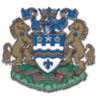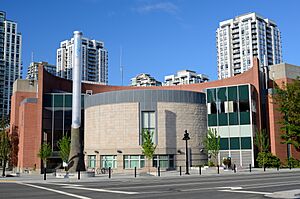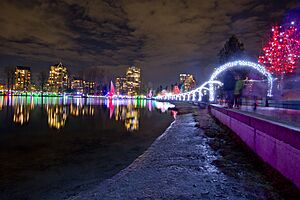Coquitlam facts for kids
Quick facts for kids
Coquitlam
|
|||||
|---|---|---|---|---|---|
| City of Coquitlam | |||||
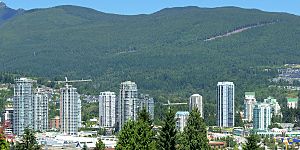
Coquitlam Town Centre
|
|||||
|
|||||
| Motto(s):
The Spirit of the Rivers is the Strength of the People
|
|||||
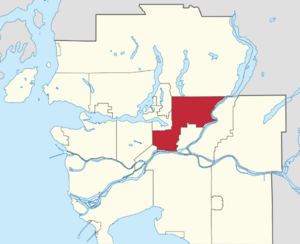
Location of Coquitlam in Metro Vancouver
|
|||||
| Country | Canada | ||||
| Province | British Columbia | ||||
| Regional district | Metro Vancouver | ||||
| First settled | 7000 BCE | ||||
| Incorporated as a district municipality | July 25, 1891 | ||||
| Amalgamated | October 7, 1971 | ||||
| Incorporated as a city | June 18, 1992 | ||||
| Seat | Coquitlam City Hall | ||||
| Government | |||||
| • Type | Mayor-council government | ||||
| • Body | Coquitlam City Council | ||||
| Area | |||||
| • Total | 152.5 km2 (58.9 sq mi) | ||||
| • Land | 122.15 km2 (47.16 sq mi) | ||||
| Elevation | 24 m (79 ft) | ||||
| Population
(2021)
|
|||||
| • Total | 148,625 | ||||
| • Estimate
(2023)
|
168,250 | ||||
| • Rank | 34th in Canada 6th in British Columbia 5th in Metro Vancouver |
||||
| • Density | 1,216.7/km2 (3,151/sq mi) | ||||
| Time zone | UTC−08:00 (PST) | ||||
| • Summer (DST) | UTC−07:00 (PDT) | ||||
| Forward sortation area |
V3E, V3J – V3K
|
||||
| Area codes | 604, 778, 236, 672 | ||||
Coquitlam (![]() i/koʊˈkwɪtləm/ koh-KWIT-ləm) is a city in British Columbia, Canada. It's mostly a suburb, meaning many people who live here travel to work in bigger nearby cities. Coquitlam is the sixth-largest city in the province, with about 148,625 people living here in 2021. It's one of 21 cities that make up Metro Vancouver. The current mayor is Richard Stewart.
i/koʊˈkwɪtləm/ koh-KWIT-ləm) is a city in British Columbia, Canada. It's mostly a suburb, meaning many people who live here travel to work in bigger nearby cities. Coquitlam is the sixth-largest city in the province, with about 148,625 people living here in 2021. It's one of 21 cities that make up Metro Vancouver. The current mayor is Richard Stewart.
The explorer Simon Fraser visited this area in 1808. He met the Coast Salish Indigenous people who had lived there for thousands of years. European settlers started arriving in the 1860s. A large lumber mill called Fraser Mills was built in 1889. By 1908, a small town had grown around the mill, with homes, a store, a post office, and even a Sikh temple.
Contents
History
The first people to live in the Coquitlam area were the Coast Salish people. We know from old artifacts that they have lived here for at least 9,000 years! The name Kwikwetlem comes from a Coast Salish phrase meaning "red fish up the river."
Simon Fraser, a famous explorer, passed through this region in 1808. In the 1860s, more Europeans began to settle here. Coquitlam started as a "place-in-between" when North Road was built. This road helped the Royal Engineers in New Westminster reach the port in Port Moody.
A big step for the young community was in 1889. Frank Ross and James McLaren opened Fraser Mills, a very modern lumber mill. The area officially became the District of Coquitlam in 1891. By 1908, a small town had grown around the mill. It had 20 houses, a store, a post office, a hospital, and a Sikh temple.
A few years later, many French Canadian mill workers came from Quebec. This led to the creation of Maillardville. It was named after Father Edmond Maillard, a young priest from France. Maillardville became the biggest French-speaking community west of Manitoba. Today, you can still see its French roots in street names, schools, and celebrations like Festival du Bois.
After World War II, Coquitlam and the surrounding areas grew a lot. The Lougheed Highway opened in 1953, making it easier to get to Coquitlam. This helped the city grow even more. In 1971, Coquitlam and Fraser Mills joined together. The mill closed in 2001, and the land is now being planned for a new waterfront community.
Geography
Coquitlam is located about 10 to 15 kilometers (6 to 9 miles) east of Vancouver. The Coquitlam River meets the Fraser River here. The city stretches northeast along the Pitt River towards Coquitlam and Pitt lakes. Coquitlam shares borders with Burnaby and Port Moody to the west, New Westminster to the southwest, and Port Coquitlam to the southeast.
To the north, you'll find mountains like Burke Mountain, Eagle Ridge, and the 1,583-meter (5,194-foot) tall Coquitlam Mountain. Coquitlam is quite large, covering about 152.5 square kilometers (58.9 square miles). This is about six times bigger than Port Moody or Port Coquitlam.
Coquitlam is in the Pacific Time Zone. This means it's 8 hours behind UTC in winter and 7 hours behind in summer.
Neighbourhoods
Coquitlam's shape is a bit like a tilted hourglass. It has two larger areas connected by a smaller middle section.
Southwest Coquitlam is the older part of the city. It includes Maillardville and the industrial area near the Fraser River. Higher up, you'll find the residential areas of Austin Heights. Many older homes here are being replaced with newer, larger ones. The Poirier Street area used to be the main sports hub.
The Austin Heights area is home to Como Lake. This is a popular spot for fishing and recreation. It's also important for wildlife, including coho salmon and great blue heron. Mundy Park is also in this area. It's one of the biggest urban parks in the Metro Vancouver region.
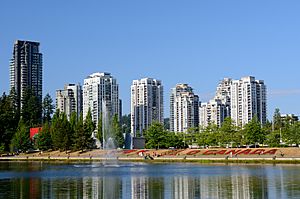
In 1984, some land from Riverview Hospital was sold and became Riverview Heights. This area now has about 250 homes. The rest of the hospital land is still used for mental health care. In 2021, these lands were renamed səmiq̓wəʔelə (pronounced suh-MEE-kwuh-EL-uh), which means "The Place of the Great Blue Heron."
Coquitlam Town Centre is a special area. It's designed to have many homes, offices, and cultural places. It's also served by rapid transit. Many important public buildings are here, like City Hall, a library, the police station, and the Evergreen Cultural Centre. You'll also find Town Centre Park and Percy Perry Stadium here.
In 1989, a large forested area on Eagle Mountain was sold. This led to the creation of Westwood Plateau. It now has over 4,500 upscale homes and two golf courses. The Westwood Motorsport Park closed in 1990 because of this development.
Today, much of Coquitlam's new development is happening in Burke Mountain, in the city's northeast. The new Evergreen Extension of the Millennium Line SkyTrain also brought more development to Burquitlam.
Climate
Coquitlam has a mild climate, like many places near the ocean. It has warm, dry summers and cool, wet winters. However, Coquitlam gets a lot of rain because it's close to mountains. When air from the Pacific Ocean hits the Coast Mountains, it cools and creates rain. This is why Coquitlam gets about 1,969 millimeters (77.5 inches) of rain each year. Most of this rain falls in the fall and winter. Summers are usually sunny with less rain.
Even though winters are mild, Coquitlam does get some snow. It averages about 64.4 centimeters (25.4 inches) of snow each year. The snow usually doesn't stay on the ground for long.
The average temperature in Coquitlam is about 10.2°C (50.4°F). In August, the average high is 22.7°C (72.9°F) and the low is 13.4°C (56.1°F). In December, the average high is 5.6°C (42.1°F) and the low is 0.9°C (33.6°F). This mild weather is thanks to the warm Alaska Current offshore and mountains that block cold air from other parts of Canada.
On June 28, 2021, Coquitlam had its hottest day ever, reaching 41°C (106°F)!
Demographics
Coquitlam has grown a lot over the years. In the 2021 Census, the city had a population of 148,625 people. This was a 6.7% increase from 2016.
Many different types of families live in Coquitlam. In 2016, about 47% of homes had a married couple with children. About 44% of Coquitlam residents were born outside of Canada, which is higher than the average for British Columbia.
Coquitlam is a diverse city. In 2021, about 41.5% of the population identified as European. Other large groups included East Asian (31.4%), Middle Eastern (8.2%), Southeast Asian (5.2%), and South Asian (5.0%).
English is the most common language spoken at home, but many other languages are also used. In 2016, about 50.47% of people spoke English as their first language. Mandarin was next at 9.66%, followed by Cantonese at 6.43%. In the Maillardville area, you'll find a community of French speakers.
When it comes to religion, about half of Coquitlam residents (50.1%) reported having no religion in 2021. Christianity was the largest religious group (37.4%), followed by Islam (6.3%), Buddhism (2.1%), Hinduism (1.3%), and Sikhism (1.3%).
Economy
Coquitlam is often called a "bedroom community." This means that many people who live here travel to other cities like Vancouver or Burnaby for work.
The main industrial area in Coquitlam is in the southern Maillardville/Fraser Mills area, near the Fraser River. Some of the biggest employers in Coquitlam include the City of Coquitlam itself, Art in Motion, and the Hard Rock Casino. Other large companies like Coca-Cola and Sony also have operations here.
In 2007, Coquitlam had 610 retail businesses, which created over 8,700 jobs. Most of these stores are found around Coquitlam Centre and in areas like Austin Heights. You can also find large stores like IKEA and The Home Depot here.
The Tri-Cities Chamber of Commerce helps local businesses. It has over 900 members, including businesses, professionals, and community groups.
Arts and culture
Coquitlam is close to Vancouver, so residents have many choices for fun activities. But Coquitlam also has many great places for arts and culture right in the city!
In 2009, Coquitlam was named a Cultural Capital of Canada by the Canadian government.
Arts and entertainment
The Molson Canadian Theatre is a large venue with 1,074 seats. It opened in 2006 as part of the Hard Rock Casino. Cineplex Entertainment also has a huge movie theater complex, SilverCity Coquitlam, with 20 screens and 4,475 seats.
The Evergreen Cultural Centre in Town Centre is a hub for arts and culture. It has a 264-seat theatre, rehearsal rooms, art studios, and an art gallery. It hosts many community events and is home to groups like the Pacific Symphonic Wind Ensemble.
Coquitlam also hosts several yearly festivals:
- Festival du Bois (first weekend in March)
- Water's Edge Festival (third weekend in March)
- Como Lake Fishing Derby (last Sunday in May)
- BC Highland Games (last Saturday in June)
- A Canada Day Celebration at Town Centre Park
- The BC Dumpling Festival (mid-August)
- The Blue Mountain Music Festival (mid-July)
Attractions
Coquitlam has lots of green spaces, covering over 890 hectares (2,200 acres). There are more than 80 city parks and natural areas. Mundy Park is the biggest, located in the center of the city.
You can also find larger parks on the city's edges, like Pinecone Burke Provincial Park, Minnekhada Regional Park, and Pitt Addington Marsh. Colony Farm is a large park with walking trails and gardens. Town Centre Park is a big city park with many fun activities. Como Lake Park and Glen Park are also popular.
Place des Arts is a non-profit arts centre in Maillardville. It started in 1972 and offers classes in visual arts, music, acting, and dance. It also has special programs for students and hosts concerts and art shows.
Place Maillardville is a community center with activities for all ages. It offers programs about French language and culture, as well as physical activities. Heritage Square has historic sites, gardens, and an outdoor amphitheatre. It's also home to the Mackin Heritage Home & Toy Museum.
The city takes care of many sports fields, including grass fields, turf fields, and ball diamonds. It also runs Percy Perry Stadium and the Poirier Sport & Leisure Complex. There are also private ice rinks for hockey.
Sports
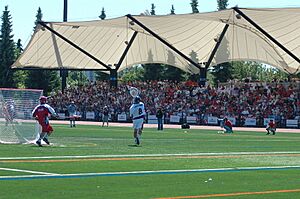
Coquitlam offers many opportunities for sports:
- Baseball – The Coquitlam Reds play their games at Mundy Park. A famous player from the Reds is Larry Walker, who became a Major League Baseball All-Star. Coquitlam Little League has been around since 1955.
- Basketball – The Tri-City Youth Basketball Association helps over 1,400 young players from grades 2 to 9.
- Cricket – The Windies Cricket Club plays at Mackin Park. There's also a youth program to teach kids about cricket.
- Football – The Coquitlam Minor Football Association has players from 6 to 18 years old.
- Golf – Coquitlam has several golf courses, including the Vancouver Golf Club and the highly-rated Westwood Plateau Golf & Country Club.
- Hockey – The Coquitlam Express hockey team plays at the Poirier Sport & Leisure Complex. Coquitlam also has a large Minor Hockey Association for young players.
- Lacrosse – The Coquitlam Adanacs play at the Poirier Sport & Leisure Complex. Coquitlam also has a Minor Lacrosse Association. In 2008, Percy Perry Stadium hosted the World Lacrosse Championships for players under 19.
- Softball – The Coquitlam Minor Softball Association has about 300 players, mostly girls, aged 5 to 19.
- Rugby – The city is home to the United Rugby Club, which has teams for men, women, and younger players.
- Soccer – Coquitlam has two major soccer groups: the Coquitlam Metro-Ford Soccer Club with over 2,500 players, and the North Coquitlam United Soccer Club.
- Swimming – The City Centre Aquatic Complex has an Olympic-size pool, a wave pool, and a waterslide. The Chimo Aquatic and Fitness Centre also has pools and a fitness room. Coquitlam has outdoor pools and splash pads too.
- Track and Field – The Coquitlam Cheetahs track and field club trains at Percy Perry Stadium, named after their former coach.
- Water Polo – Coquitlam has several water polo clubs, including the Coquitlam Sharks and the Coquitlam Lions.
Transportation
Coquitlam's public transportation and major roads are managed by TransLink.
The city has four SkyTrain stations on the Millennium Line. This line, called the Evergreen Extension, connects Coquitlam City Centre to Port Moody and then to the existing Millennium Line.
There are also many bus routes that run throughout Coquitlam and connect it to other cities in Metro Vancouver. A main bus hub is at Coquitlam Central Station.
The West Coast Express is a commuter rail service that stops at Coquitlam Central Station. It takes people to downtown Vancouver in the mornings and brings them back in the evenings, Monday to Friday.
For drivers, the Trans-Canada Highway offers freeway access to nearby cities like Burnaby, Vancouver, and Surrey. Lougheed Highway is another important road that goes through Coquitlam.
Coquitlam has 60 kilometers (37 miles) of bike routes, including special bike lanes on many streets and paths through city parks.
Coquitlam is served by two international airports: Vancouver International Airport to the west and Abbotsford International Airport to the east. There are also smaller airports nearby for private planes.
If you want to travel to Vancouver Island or other islands, you can use the BC Ferries service. They have large ferries that carry cars and passengers. One of their ferries, the Queen of Coquitlam, was launched in 1976 and can carry many cars and people.
Infrastructure
Police, fire, emergency services
Coquitlam's police services are provided by the Royal Canadian Mounted Police (RCMP). The main police station is next to City Hall, and there are smaller community police stations in other areas. The Coquitlam RCMP also serves the nearby towns of Anmore, Belcarra, and Port Coquitlam.
Coquitlam has its own fire department, Coquitlam Fire/Rescue, with four fire halls located around the city.
Like all cities in British Columbia, Coquitlam's ambulance service is run by the British Columbia Ambulance Service.
Coquitlam Search and Rescue is a volunteer team that helps find people who are lost in urban areas or the wilderness. They cover a large area, including Coquitlam and its neighboring communities.
Community centres
The city manages four community centers for all ages: Centennial, Pinetree, Poirier, and Summit. There are also two community centers specifically for seniors: Dogwood Pavilion and Glen Pine Pavilion.
Education
Coquitlam is part of School District 43 Coquitlam. It has four public secondary schools (high schools), seven middle schools, and many elementary schools. French-speaking students can attend schools run by the Conseil Scolaire Francophone de la Colombie-Britannique.
The David Lam Campus of Douglas College is located in Coquitlam Town Centre. It has about 4,000 students and offers programs that help students transfer to universities, get career training, or upgrade their academic skills.
There are also two major universities, University of British Columbia and Simon Fraser University, in nearby cities. The British Columbia Institute of Technology (BCIT) in Burnaby offers hands-on technical education.
The Coquitlam Public Library has two branches: City Centre and Poirier. They have over 1.1 million items that people can borrow.
Media
In addition to the news from other parts of Metro Vancouver, CKPM-FM was the first radio station just for the Tri-Cities area, starting in 2009.
Coquitlam also has its own local newspaper, the Tri-City News, which comes out twice a week.
Many movies and TV shows have been filmed in Coquitlam. Some famous ones include Deadpool 2, Godzilla, parts of the Twilight series, The X-Files, Juno, and Smallville. The city even has a Coquitlam Film Office to help with filming permits and other needs.
Sister cities
Coquitlam has special "sister city" relationships with other cities around the world. These relationships help promote cultural exchange and friendship.
In 2017, Coquitlam ended its sister city relationships with Laizhou, Tochigi, Ormoc, and San Juan.
Notable people
Many interesting people have come from Coquitlam:
- Matthew Good: A Juno Award-winning rock musician who graduated from Centennial Secondary. He was the lead singer of the Matthew Good Band.
- Taylor Kitsch: An actor who graduated from Gleneagle Secondary. He has starred in movies like John Carter and Battleship.
- Craig Forrest: A former professional soccer goalkeeper who played in the Premier League and for the Canadian national team. He also attended Centennial Secondary.
- Lars Hansen: A former National Basketball Association player who was part of the Seattle SuperSonics team that won the 1979 NBA Championship. He played high school basketball at Centennial Secondary.
- Rachel Marsden: A political analyst and former TV co-host.
- Lui Passaglia: A former professional football player for the BC Lions, who has lived in Coquitlam for over 20 years.
- Chris Tse: A spoken word poet who was raised in Coquitlam.
- Joey Albert: A Filipino pop and jazz singer.
- Mathew Barzal, Dante Fabbro, and Vincent Iorio: Hockey players who were born and raised in Coquitlam and play in the NHL.
- Dennis E. Taylor: A science fiction novelist who lives in Coquitlam.
Images for kids
-
Westwood Plateau, with Burke Mountain behind it and Golden Ears Provincial Park in the distance
See also
 In Spanish: Coquitlam para niños
In Spanish: Coquitlam para niños



